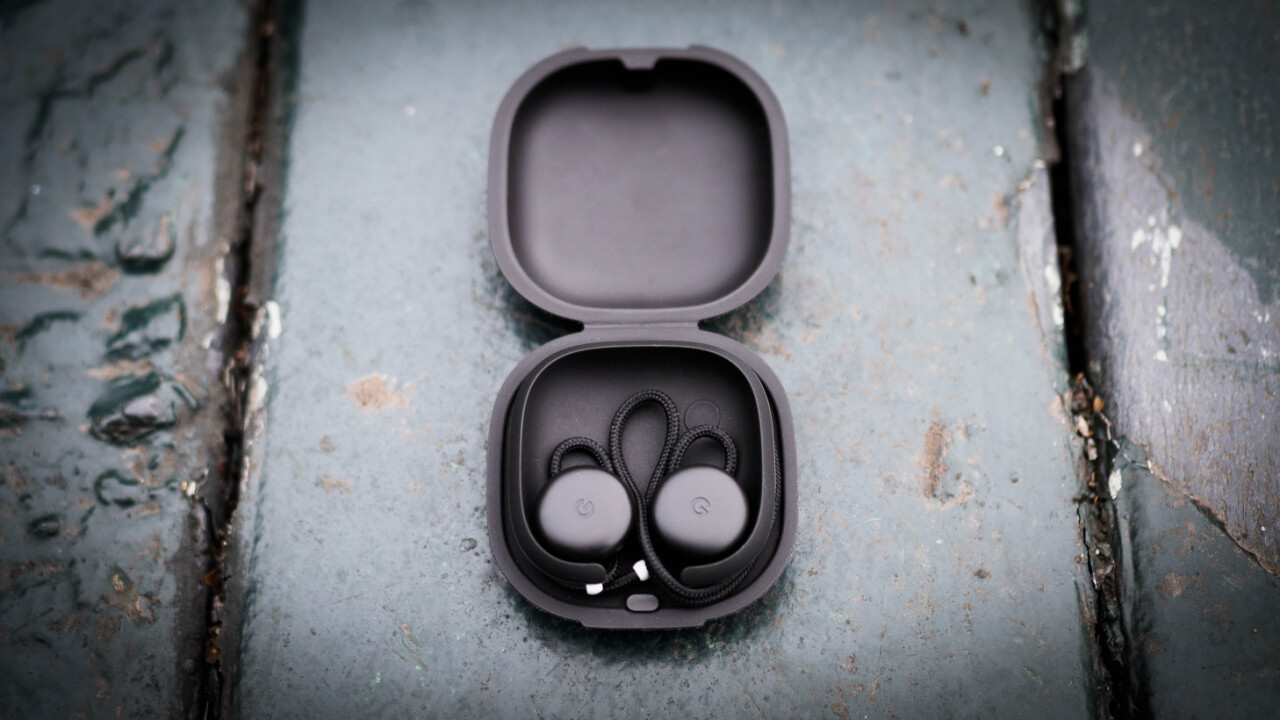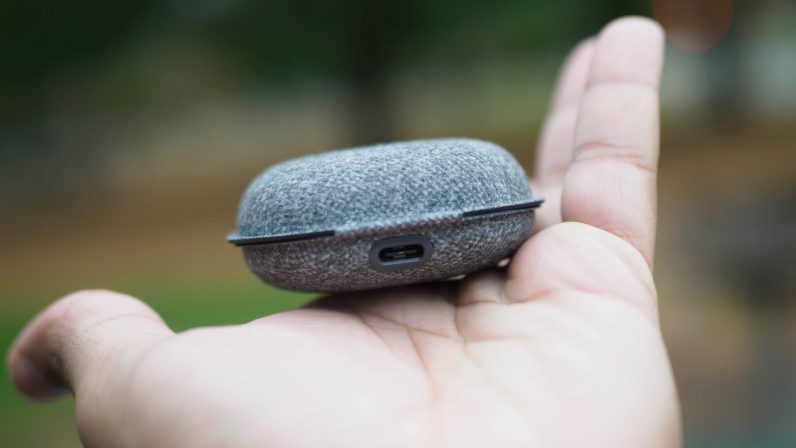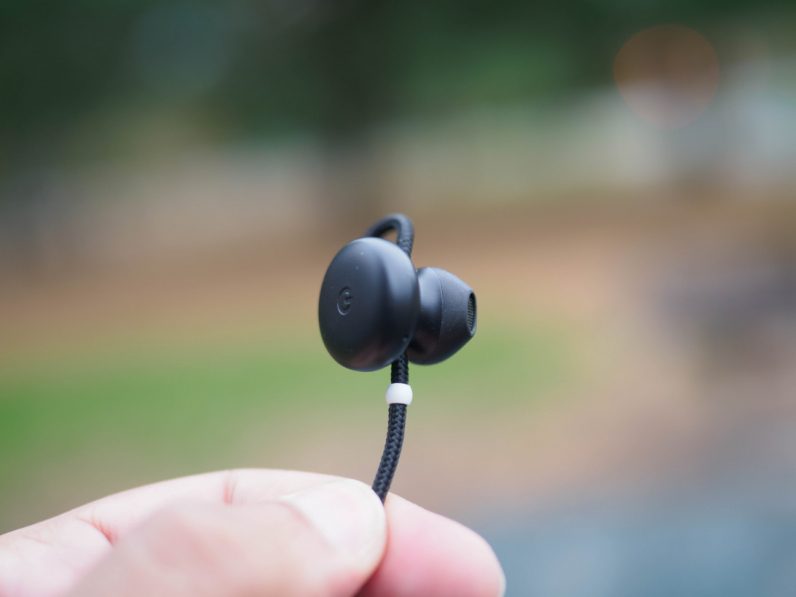
In many ways, Apple’s AirPods feel like a hardware manifestation of iOS’ defining characteristics: simplicity and design, sometimes at the expense of practicality. Google’s Pixel Buds play the same role for Android. They’re powerful, smart, and sometimes a little bit messy.
That’s been reflected in reviews so far (yes, writers read other reviews), with reporters often citing the usefulness of the Assistant but decrying Google’s design or sound as being average or underwhelming. But I’m firmly on the other end of the spectrum. Despite notable flaws, I not only like the Pixel Buds, but think they’re some of the best headphones I’ve used in their price range in quite some time.
Design
Aesthetically, at least, I’m of the mind that Google is a step ahead of Apple. I love the fabric on the Pixel Buds’ case, which makes the whole package feel less gadget-y. I also quite like the way like the way Pixel Buds look in the ear, with it’s circular form appearing less obnoxious than the Bluetooth earpiece vibe the AirPods and most other Bluetooth headphones give off. While I think the white and blue models look quite good, the black model I’m trying is good option for those who prefer something more understated. The AirPods, meanwhile are about as far from understated as earbuds get.
Then there’s that wire. Your mileage may vary, but I’m glad it’s there. I’ve yet to use fully wireless Bluetooth headphones that don’t make me at least a little paranoid I’m going to lose one. I like being able to wear them around my neck when I need to. Besides, the short braided cable is a lot less irksome than the usual giant neckband. And though some people hate wrapping their cable around the case, I don’t mind it, and better than having to than untangle wired headphones.
My qualm is that the cable might be a bit too long; as the weather gets colder, it’s easy for the cable to get stuck under a scarf if you wear it behind the neck like Google expects you too. For this reason, I’ve often ended up wearing them with the cable wrapped over my ears like a pair of sports headphones, which provides a much more secure fit anyway. Still, I’d rather have the cable than losing my headphones altogether.

Side-note: After using a few headphones with USB-C charging, including the Pixel Buds, I now refuse to buy anything that charges with micro-USB.
I’m much less fond of Google’s choice to go with an AirPod-style open design though. I’ve never found a pair of non-sealed earbuds that were particularly comfortable for long-term use, and the Pixel Buds are no exception. On the other hand, using the cable loop as an ear anchor is a little bit of design genius that helps them feel stable during workouts.
Still, headphones using silicone or foam tips can adapt more easily to different ear shapes, plus they provide much better isolation from noise – sometimes even better than noise-cancelling headphones. I get that some people prefer to be aware of their surroundings, but many headphones can now use the microphones to help you hear the world – but only when you want to.
Sound
The open design also made me worry about sound quality, and I expect a lot of people to similarly dismiss them simply for their design. But much to my surprise – and unlike some other reviewers – I found the Pixel Buds actually sound quite good. Not just “good for earbuds,” but fairly competitive with other earbuds in their price range, especially wireless ones.
The lack of a seal does mean that you lose out a little on the very lowest frequencies, but the Pixel Buds still extend surprisingly low given their design. They can play down to 30 hz without much trouble, and even 20 hz is still audible, if quiet.
The open design means Google overcompensates for bass dissipation, and as a result, the driver can’t quite keep up with really fast bass on busy tracks, particularly at low volumes. But unless you’re a real basshead, it should be suitable for even bass-heavy genres like hip hop and drum and bass.
The rest of the frequency range is handled tastefully too. Mids are little warm thanks to a slight midbass bump, but they avoid sound muddy. Treble is a teensy bit more recessed than I prefer, but the detail is all there, lending plenty of sparkle on crashing cymbals and texture on strings without any grating sibilance. The tuning on the whole reminds me a bit of the Sennheiser house sound, perhaps a tad warmer.

With the exception of the muddier low end, I found the sound pretty comparable to some of my favorite in-ear monitors, the RHA MA750 and B&O H3. Besides, the open design can sometimes be a boon. While I wouldn’t call the soundstage particularly large, the airy sound and ample dynamics help make the Pixel Buds solid choices for classical and acoustic recordings. Also, they get really loud. Not great for your ears, but you’ll be able to hear your music in the subway.
All that being said, I still can’t help but wonder why Google didn’t go with a sealed design. The company is clearly using high-quality drivers in the Pixel buds; it probably could have outperformed the AirPods water sound-wise, provided better isolation, and made them more comfortable with a proper sealed design.
The Assistant
But of course, the Pixel Buds aren’t really aimed at audiophiles; their selling point is their smart features. The way I see it, they’re a flawed but enticing look at what the future of smart headphones can be.
First the bad: Pairing is messy, even though my initial experience was actually just as Google sold it. After removing some protective stickers, opening up the case made a pop-up to show up on my Pixel 2 XL asking me to connect the headphones. You’re then greeted by a helpful tutorial sequence.
The problems arose after I wanted to pair it to other devices, or re-pair them to my own phone. After that initial set-up, simply opening the case never did anything again. To pair them to another device, you’ll need to put the buds back in the case and hold down a button. On Android phones, that’ll prompt the connection pop-up to appear. Otherwise, it’s the standard irksome Bluetooth setup process, with the added pain of having to put the buds back in the case for pairing. Needless to say, these aren’t ideal headphones to be used with multiple devices.

But they certainly do shine when paired to an Android device, the Pixel 2 in particular. While plenty of Bluetooth headphones allow you talk to the Google Assistant by holding down a button, the Pixel Buds are on a completely different level of usefulness.
On the Pixel Buds, the Assistant is more accessible than ever. When you get a notification, you’ll hear a small ‘ding,’ and Google will even tell you who it’s from if it’s someone you speak to regularly. For a few seconds after receiving a notification, you can tap on the right earbud to reply. It’s a small feature, but I was surprised at how often I used it to compose messages when doing things like washing the dishes or walking my dog.
At any moment, you can double tap on the earbuds to have the assistant read out your notifications. But most helpful design touch is simply how you activate the assistant for everyday inquiries.
On most headphones, you need to hold down a button for two seconds, wait for a ding, and then begin to speak. On the Pixel Buds, you speak while you’re holding down the right earbud. The difference is Google starts listening right away – as you first tap the headphones – and is ready with an answer almost immediately after you let go.
It may seem like a small advantage over simply holding down a button for two seconds, but the Pixel Bud’s speed goes a long way towards making the Assistant experience feel more conversational. In fact, testing the Pixel Buds is the most I’ve used a voice assistant of any kind.
On a regular basis, I would ask it to reply to messages, tell me what song is playing, set reminders, make a call, make calculations, etc. These are all things I can do on my phone, but my phone usually lives in my pocket. When I’m on the move, the buds are often just easier to use.
The only other gesture you can perform is a swipe back or forward to change volume, which worked reliably. Skipping tracks is relegated to voice commands, but it’s so fast I don’t mind this nearly as much as I expected to.
Keep in mind the buds aren’t the only headphones that will have such deep integration with the assistant – or even the first. Bose’s QC35 II showed off the tech, called ‘Voice UI,’ earlier this year, and more such headphones are on the way.
If you’re wondering about the real-time translation feature Google showed off, it’s pretty cool – though not quite as seamless as Google implied. Basically, asking Google something like “Help me speak Spanish” will simply open Google Translate, but there isn’t much the Pixel Buds do that Google Translate can’t already do on its own, and the person you’re talking to still has to press a button for translation to work. The main difference compared to using Google Translate on its own is that the person you’re talking to doesn’t hear their voice translated, so it all feels a little more natural.
But on the other hand, when used on your phone, Google Translate has an option to automatically detect who is speaking and translate voices without anyone pressing anything, which is arguably more practical. If anything, all the Pixel Buds really did was make me realize how good the Translate app has gotten.
On a practical note, battery life was good. Four to five hours of playback time per charge seems about right, and the case includes enough battery power for a full 24 hours of music. Aside from when I purposefully ran the battery down, I never came close to depleting the battery. My Bluetooth connection also never dropped or spazzed, something still surprisingly common in 2017.
Flawed, but well-rounded

The Pixel Buds are not for everyone, and they clearly show signs of being a first generation product. The fit could be better, pairing is messier than it should be, and the open design isn’t for everyone. Google has some kinks to work out for the second generation, and if you only care about sound quality or there are plenty of better options for the price.
But despite owning dozens of headphones and testing three others at the same time as the Pixel Buds, they’re the ones I end up wearing on the go most often. As far as I’m concerned, the Pixel Buds deliver on their promise of making the Google Assistant more useful than ever, while sounding pretty great, too.
Get the TNW newsletter
Get the most important tech news in your inbox each week.




